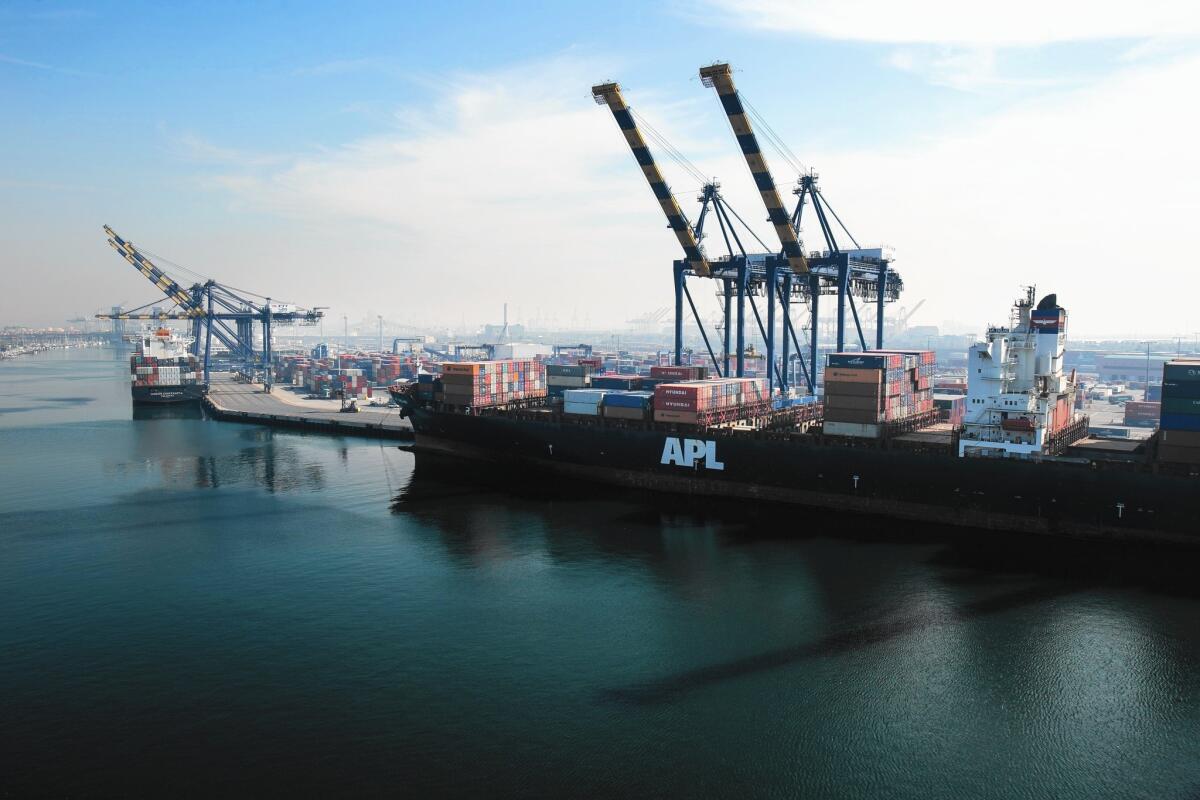Ports of L.A. and Long Beach see best year since before recession

The nation’s busiest port complex saw its best year since before the Great Recession, a sign of renewed economic strength across the country.
Analysts said the cargo increase at the ports of Los Angeles and Long Beach — coming despite severe problems moving cargo off the docks and uncertainties over a new dockworker contract — shows that the U.S. economy is kicking into a higher gear.
“We are throwing off the shackles of the recession,” international trade economist Jock O’Connell said.
Locally, logistic jobs increased and dockworker pay surged as businesses throughout the United States ordered more products from Asia to meet growing demand at home. Cargo volumes at the neighboring ports climbed nearly 4% from 2013 to 15.2 million container units, making 2014 the third-busiest year on record, behind only 2006 and 2007.
The San Pedro Bay harbors, which handle roughly 40% of U.S. imports, serve as the nation’s premier gateway to Asia, accepting goods destined for locales across the country. The complex benefited last year from the strongest national job growth since 1999. President Obama used those figures during the State of the Union address to argue that “the shadow of crisis has passed.”
A growing U.S. economy pushed imports up nearly 5% last year in L.A. and Long Beach. But exports fell 2.5% as growth slowed overseas, economists said.
Continued U.S. economic expansion is likely to send cargo volumes higher this year, trade experts said. A strong dollar should provide further support for imports, which account for far more traffic than exports at the ports.
As the U.S. economy hits a “cruising speed,” cargo volume probably will rise around 4% this year, said Robert A. Kleinhenz, chief economist with the Los Angeles County Economic Development Corp.
Firms in the local goods movement industry are betting that higher volumes are here to stay.
Warehouse developer and landlord Goodman Birtcher has five Southern California logistics centers in the works worth a total of $738 million.
“Southern California is a prime growth market,” Chief Executive Brandon Birtcher said.
The cargo increase wasn’t without pitfalls, however, and it laid bare festering problems in the supply chain. A shortage of the trailers that truckers use to haul goods from the ports and the increased use of behemoth container vessels — which unload more cargo onto terminals than ships of old — helped create the worst congestion crisis in a decade.
Business are still grappling with debilitating delays and some are losing sales as a result, placing a drag on the national economy, experts said.
According to employers operating shipping lines and terminals, the dockworkers union has worsened congestion since November by refusing to dispatch many skilled crane operators who place goods onto trucks and rail cars. Employers say the union is trying to gain leverage in contract talks that have dragged on for more than eight months.
The union has a different take: Bobby Olvera Jr., president of the International Longshore and Warehouse Union Local 13 in San Pedro, said the union limited the number of untrained, noncertified crane operators available to work for safety reasons after several accidents. Employers have failed to train enough operators and could fill crane positions with their own employees if they choose to, he said.
The union points to management decisions as causing congestion, including the move by shipping lines to stop providing trailers to truckers over the last year and a half.
Regardless of who’s to blame, the continued delays and labor uncertainty threatens cargo growth this year, economists said. During 2002 negotiations, following slowdown accusations, employers locked out dockworkers for 10 days, shutting ports up and down the coast in the process.
Already, some importers are looking elsewhere, seeking to avoid the bottleneck and fearful that a work stoppage could arrive on the docks.
“We need to dig in and work every day to earn that cargo back,” said Gene Seroka, executive director of the port of Los Angeles. “I believe it will take some time, but that the issue is fixable.”
One important step, Seroka said, is a new contract for roughly 20,000 dockworkers at 29 West Coast ports, who have been working without one since July.
Twitter: @khouriandrew
More to Read
Inside the business of entertainment
The Wide Shot brings you news, analysis and insights on everything from streaming wars to production — and what it all means for the future.
You may occasionally receive promotional content from the Los Angeles Times.











